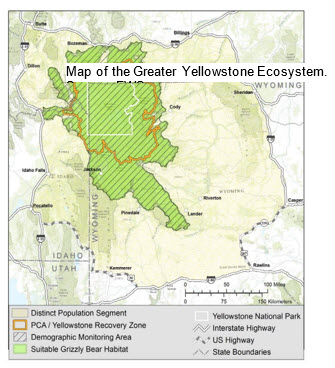WASHINGTON, May 18, 2016 - The public comment period on the U.S. Fish and Wildlife Service’s proposal to remove the Yellowstone population of grizzly bear from the endangered species list closed last week after more than 5,700 comments were submitted.
The vast majority were authored by individuals opposed to delisting, while most of the trade associations and government agencies representing natural resources or agriculture applauded the move to discontinue what now adds up to 40 years of federal protections for the bear.
Take the joint statement submitted by the Idaho Department of Fish and Game, Montana Fish, Wildlife and Parks, and the Wyoming Game and Fish Department – the agencies responsible for wildlife management in the three states that the Yellowstone grizzly bear population inhabits.
The agencies said in their comment that they had agreed to cooperate with FWS and one another to maintain the bear’s population levels above 500 animals, including at least 48 females with cubs, within what is called the Demographic Monitoring Area – which spans suitable grizzly habitat and covers the Yellowstone Recovery Zone and the Yellowstone National Park. The 500-bear population level, they say, is a “conservative” minimum originally laid out in FWS’ Conservation Strategy, which was released as a final draft in February.
In anticipation of a proposed delisting (FWS chief Dan Ashe indicated in September 2015 that a proposal was imminent), the states released a draft plan that divvied up the number of bears that could be hunted in each state. Montana has also designated fall and spring hunting seasons for the bear, and even set prices for grizzly hunting permits: $150 for state residents and $1,000 for out-of-state hunters.
Within the Greater Yellowstone Ecosystem (GYE), FWS estimates there are over 700 grizzlies – at least 200 more than what FWS set as a minimum recovery level. Federal and state biologists are generally in agreement that the Yellowstone grizzly has fully recovered from the excessive hunting and trapping that nearly eliminated the species in the early 1900s, but other scientists are not convinced – and said as much in their comments.
Jane Goodall, a biologist well known for her work with great apes, joined more than 50 other scientists who signed a letter to FWS urging the agency to rethink its push to delist.
“GYE grizzly bears are not recovered,” the scientists wrote. “Before 1800, approximately 50,000 grizzly bears roamed the lower 48 states between Canada and Mexico. Today, wild grizzly bears number fewer than 1,700 individuals in the lower 48 states, (and) while FWS claims that there are 700 grizzly bears in the GYE, this is a contested figure.”
 The letter went on to say that due to shortages in staple grizzly
food sources, like whitebark pine seeds, native cutthroat trout, huckleberries,
army cutworm moths, elk and bison – declines caused by habitat loss, climate
change, drought and invasive species, the scientists said – the grizzly bear
population can’t withstand trophy hunting.
The letter went on to say that due to shortages in staple grizzly
food sources, like whitebark pine seeds, native cutthroat trout, huckleberries,
army cutworm moths, elk and bison – declines caused by habitat loss, climate
change, drought and invasive species, the scientists said – the grizzly bear
population can’t withstand trophy hunting.
What’s more: “Grizzly bears, in the human economy, are worth far more alive than dead,” they wrote.
“In 2015, Yellowstone (National Park) received 4.1 million visits and Grand Teton had 4.6 million, contributing $890 million to Wyoming’s gateway communities, and $1.1 billion to Wyoming’s overall economy. These figures greatly outweigh revenues generated by either Wyoming’s livestock or hunting industries.”
Most agricultural groups that commented on the rule didn’t cite livestock predation as evidence that the population had fully recovered, or as a reason to delist the grizzly. Instead, one of the chief complaints of livestock owners operating within the grizzly’s management area is that the bear’s ESA habitat protections reduced livestock grazing allotments. The Montana Stockgrowers Association, for instance, said in addition to delisting the bear, FWS should also make clear that grazing allotments are not in conflict with the predator’s conservation.
For the past 20 years, Defenders of Wildlife paid Montana and Idaho ranchers for livestock losses proven to be or “probably” due to grizzly attacks. In its comments, the group said its indemnity payments to livestock owners totaled more than $423,000 (Wyoming has its own indemnity fund) and said it has invested $1 million into grizzly coexistence projects in the three states to help keep grizzlies from interacting with livestock or humans.
Other environmental groups, like the Center for Biological Diversity, submitted comments, too, along with almost 30,000 comments from its supporters, against the delisting. The Humane Society of the United States posted 81 documents in total (mostly research papers on grizzly bears) to the Federal Register in opposition to delisting. And Louisa Willcox, a long-time advocate for grizzly bear protection and founder of the Grizzly Times blog, outlined her argument against delisting in 50 pages.
Serena Baker, public affairs specialist for the FWS Mountain-Prairie Region, told Agri-Pulse the agency will start analyzing the “substantive comments” made on the delisting rule, and “hope(s)” to reopen public comment once supplementary management and conservation plans have been reviewed. The agency’s goal is to decide on whether or not to delist by the end of 2016.
#30
For more news, go to: www.Agri-Pulse.com
